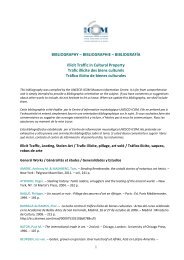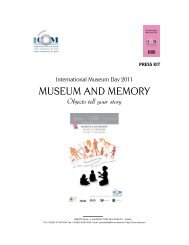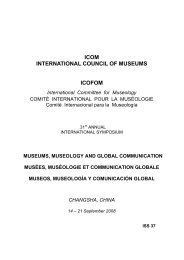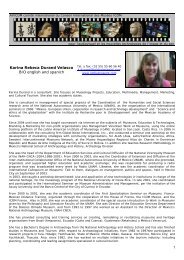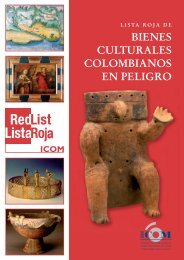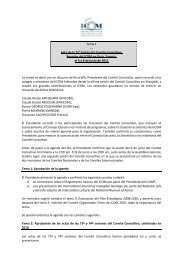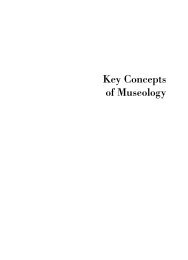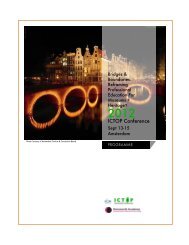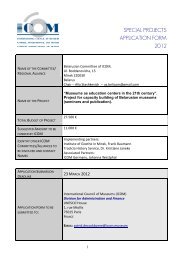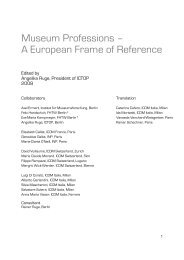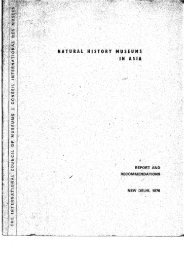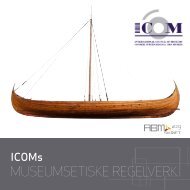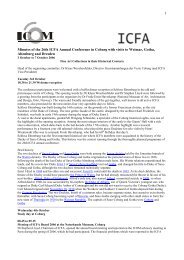ISS 25 (1995).pdf - The International Council of Museums
ISS 25 (1995).pdf - The International Council of Museums
ISS 25 (1995).pdf - The International Council of Museums
Create successful ePaper yourself
Turn your PDF publications into a flip-book with our unique Google optimized e-Paper software.
Magpies on Mount Helicon ?<br />
Peter van Mensch<br />
Nine magpies, birds who can imitate any Idnd <strong>of</strong> sound, had sealed on the boughs, and were lamenting their<br />
fate. As Minerva showed her surprise, the Muse explained: '<strong>The</strong>se, too, hove but recently joined the ranks <strong>of</strong> the<br />
birds, as a result <strong>of</strong> being defeated in a competition. <strong>The</strong>ir father lVl1S Pierus, a rich landowner <strong>of</strong> Pella. and<br />
Euippe <strong>of</strong> Poeonia \VaS their mother. Nine times she called upon powerful Lucina to come to her assistance. for<br />
nine times she found herself with child. <strong>The</strong>n the foolish band <strong>of</strong> sisters, swollen with pride in their number,<br />
journeyed through the many cities <strong>of</strong> Haemonia and Achaeo, till they came to Helicon, where they issued this<br />
challenge to us: "Stop imposing upon uneducated people, pretending 10 be sweet singers: if you have confidence<br />
in your powers, divine daughters <strong>of</strong> 77zespis. enter into competition wilh us. We are not inferior to you in voice<br />
or skill, we are your eqUllls in number. If you are defeated, you will leave the spring ( ... J; or else we, in our<br />
tum sholl with draw beyond the plains <strong>of</strong> Macedon ( ... J. Let the nymphs judge our performance". Truly, it<br />
shamed us to compete with them, but it seemed even more shameful to yield without struggle. Nymphs were<br />
chosen, and sworn in by their rivers. <strong>The</strong>n they took tlreir seats on blocks <strong>of</strong> living rock. ( ... J <strong>The</strong> nymphs agreed<br />
unanimously that tire goddesses <strong>of</strong> Helicon were tire victors. Our defeated opponents replied by hurling abuse at<br />
us, until I exclaimed: "So, it is not enough thot you have deserved punishment by forcing this COnlest, but you<br />
add insuit to in;ury ? Our patience is not unlimited: we shall follow where our anger prompts, and proceed to<br />
punish you". <strong>The</strong> Macedonian women laughed and scorned my threats, but as they tried to speak, menacing us<br />
with loud cn"es and wanton gestures, they saw feathers sprouting from their nails and plumage covering their<br />
arms. <strong>The</strong>y looked at each other, watching their faces narrow inlo horny beaks, as a flew addition was made to<br />
the birds <strong>of</strong> the forest. When they tried to beal their breasts, the movement <strong>of</strong> their arms raised them, to hoVer in<br />
the air. <strong>The</strong>y had become magpies, the scandalmongers <strong>of</strong> the woods. Even now, as birds, they still retain their<br />
original power <strong>of</strong> speech. <strong>The</strong>y still chatter horshly and hove an insatinble desire to UJIK.<br />
Describing the development <strong>of</strong> museological thinking this story as told by Ovid seems to<br />
be an apt metaphor. Established positions are challenged. <strong>The</strong> ruling elite pretends to hold<br />
the keys <strong>of</strong> Truth and Beauty. <strong>The</strong> contenders are put aside and accused <strong>of</strong> advocating<br />
Untruth and Ugliness.<br />
<strong>The</strong> purpose <strong>of</strong> this paper is not to identify the Muses and the magpies. <strong>The</strong> paper is an<br />
attempt to describe the development <strong>of</strong> museological thinking - and in particular the<br />
position <strong>of</strong> New Museology - from a dialectic perspective.<br />
<strong>The</strong> history <strong>of</strong> the development <strong>of</strong> museology as (academic) discipline is very much<br />
connected with the history <strong>of</strong> pr<strong>of</strong>essionalization <strong>of</strong> the museum field'. This interaction<br />
can be analysed from three different perspectives referring to three approaches as to the<br />
purpose <strong>of</strong> museological understanding. <strong>The</strong>y have been described as: the empirical-theoretical<br />
approach, the praxeological approach, the philosophical-critical approach. <strong>The</strong>se<br />
2<br />
Ovid, Metamorphoses. Book V: <strong>The</strong> Pieri des transformed (290-678). <strong>The</strong> English tTanSlation is<br />
taken from Mary M. Innes' edition as published by Penguin Books (1955) 1971, pp. 124-133.<br />
P. van Mensch, 'Museo1ogy, museum training and the challenge <strong>of</strong> a new century', in: P.Dube &<br />
M.C.Rocher eels., Museum training: practices and theories. Proceedings ICTOP 1992 (Quebec<br />
1992 (<strong>1995</strong>)) 147-153.<br />
133



